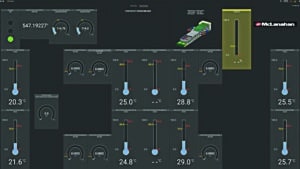McLanahan has developed a condition-monitoring package designed to improve mining customers’ productivity and efficiency.
The mining industry is constantly seeking ways to improve productivity and efficiency of operations through reduced downtime, increased equipment reliability and technological advancements.
One such innovation that has captured the attention of a mine site in New South Wales is automated condition monitoring. In a bid to achieve optimum processing efficiency and profitability, the site’s operators have successfully integrated condition-monitoring technology into its crushing operations.
McLanahan Corporation, a global manufacturer of aggregate and mineral processing equipment, provided the condition-monitoring packages.
This technology was installed on three pieces of the customer’s crushing equipment, which includes a McLanahan feeder breaker, secondary sizer and tertiary sizer.
The packages are tailored to the site and allow the company to better understand the conditions of its crushing equipment while in operation.

McLanahan’s condition-monitoring package was developed to allow its technicians, along with the customer, to better understand the health of a machine in the field. Technicians can dial into the machine remotely and pass any data back to the company’s engineering team, providing information such as the need for spare parts, overhauls or repairs.
The NSW customer’s site was first upgraded with condition monitoring in August 2020, whereupon sensors were strategically fitted to its tertiary sizer, feeding information back to McLanahan via a remote data communication device.
“The condition-monitoring package can be installed on the full suite of McLanahan equipment, from the smallest machine to the largest machine,” McLanahan electrical design manager Daniel Fairwebster said.
“We can offer a machine with a basic level of package with a basic level of instrumentation, and we can scale it up as required.”
By having a constant monitor on a one or more pieces of equipment, the customer and the manufacturer can ensure they are aware of the lifespan of the machine, as well as any faults that should arise. They can also spot any potential adjustments that can be made in future designs to better suit both parties.
Several equipment conditions and events can be monitored.
Vibration analysis
The condition-monitoring package can use vibration analysis to facilitate failure recognition by separating the signal’s output by the vibration analysers into frequency and amplitude measurements and allowing the user to determine anomalies within the machinery.
Some of the most common issues in the industry include gearbox failures, misalignments, bearing failures and electrical faults in specific parts of the machinery.
The condition-monitoring package can alert the customer when these issues begin to arise, allowing them to pre-empt potential failures and plan accordingly, reducing downtime and enhancing productivity and efficiency.
Temperature monitoring
The condition-monitoring package can use temperature monitoring to show whether any anomalies are taking place in most major components within the equipment.
Data is logged based on any major fluctuations across the equipment. This highlights any drops or rises in temperature to ensure specific components of the machinery are not overheating, locked or generally malfunctioning in a state that would change the temperature.
Speed measurement
Speed measurement allows for the equipment’s runtime to be calculated based on the load weight, temperature and vibration.
Monitoring the speed means the customer can check on the functionality of the equipment based on a variety of factors, generally co-measured before reviewing results.
Motor current
By monitoring the motor current, a customer can determine when their machinery is at its capacity, its lowest working rate, and its peak load weight.
Analysing the load allows a customer to see when their equipment is operating at its best and what factors, in terms of capacity, affect its ability to operate efficiently.
Condition monitoring helps customers reduce downtime and improve equipment reliability. It utilises sensors to monitor different events and can be customised to suit specific site and individual requirements. It allows customers to pre-empt any potential issues based on previous equipment knowledge.
As with the NSW mine customer, employing a condition-monitoring package ensures machinery is monitored closely and any potential issues are acknowledged with foresight, ultimately enhancing productivity and efficiency.
This feature appeared in the September 2023 issue of Australian Mining.




